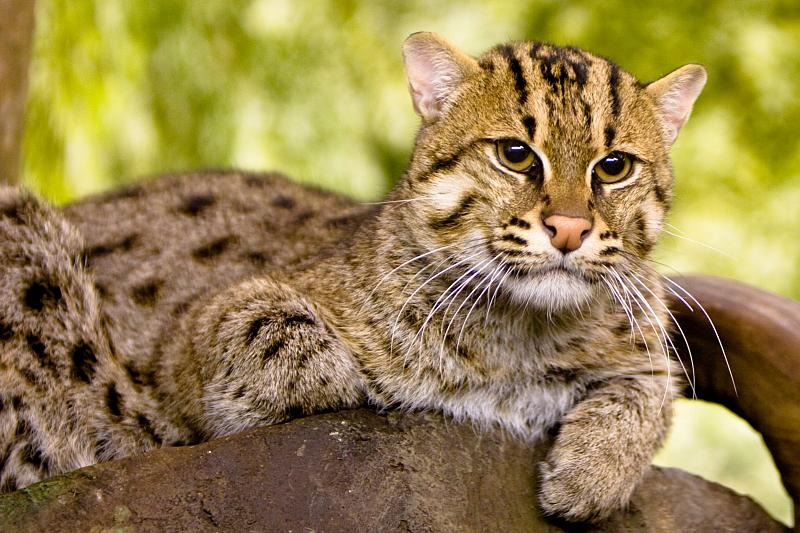First-ever photographic evidence of a Fishing Cat, an endangered animal in India, was confirmed in the Panna Tiger Reserve, Madhya Pradesh. The endangered animal was first spotted here two years ago in 2019. The Reserve authorities confirmed the animal’s existence after two years of extensive studies.
The Endangered Fishing Cat
The Fishing Cat or Prionailurus Viverrinus is a medium-sized cat endemic to South and Southeast Asia. It is mostly found in wetlands and is among the 15 felids (cat) species that inhabit India. Since 2016, the State animal of West Bengal, the fishing cat has been listed as ‘vulnerable’ on the IUCN Red List. Less than 10,000 fishing cats are left in the world.
These are threatened by the destruction of wetlands and have declined severely over the last decade. Fishing cat preys mainly on fish, but also consume mollusks, arthropods, amphibians, reptiles, birds, small mammals, and deer fawns.
What are endangered species?
The species of animals, plants, birds, or insects whose existence is threatened over a period of time, triggered by mindless human activities that affect their habitat or distort their food cycle, thus pushing them on the verge of extinction, are classified as endangered species.
The International Union is the deciding body that decides whether a species is ‘endangered’ or not, based on different criteria.
Endangered Species in India
According to International Union for Conservation of Nature (IUCN), India, with only 2.4% of the world’s land area, accounts for 7-8% of all recorded species, including over 45,000 species of plants and 91,000 species of animals. India’s forest lands nurture about 500 species of mammals and more than 2,000 species of birds. However, several species among these are facing survival issues, with some being extinct, critically endangered, and vulnerable.
Not just the fishing cat, several other species of animals and birds are endangered in India. The population of red panda has significantly reduced by about 50%, on the other hand, altering the natural flow of the river due to the construction of dams and other infrastructure in and around the river has put the Gangetic Dolphins on the list of endangered animals.
The other species on the endangered list include Red Panda, Snow Leopard, Tibetan Wolf, Great Indian Bustard, Asian Elephant, Bengal Florican, Nilgiri Marten, Stripe-necked Mongoose, one-horned Rhino, among several others.
The pink-headed duck is feared extinct since 1950 while the Himalayan quail was last reported in 1876.
Recently discovered species in India
After 70 years of being declared extinct, Cheetahs have been reintroduced in India. Similarly, the population of Tiger, once on the verge of getting extinct, has also revived. The Padmaja Naidu Himalayan Zoological Park in Darjeeling conserves the endangered animal species like red panda and snow leopard.
Why the discovery of endangered species is significant?
Sumatran elephants, a critically endangered animal, feed on a variety of plants. They deposit seeds wherever they go, contributing to a healthy forest ecosystem. They also benefit the other species that share the habitat with them and help them thrive in a healthy habitat.
Every creature on planet Earth has an important role to play. While one may help in clearing the waste, like the vulture (also getting extinct), the other may help natural afforestation, like the elephants.
Jeopardizing pollination: 75% of the world’s food crops are partially or completely pollinated by insects and other animals. The loss of pollinators could result in a decrease in seed and fruit production, leading ultimately to the extinction of many important plants. Elephants, monkeys, parrots, bees, etc are some of these species that help in pollination.
Web of life: Each actor of our valuable ecosystem is intertwined in a delicate balance, where every action on part of one actor has a far-reaching impact on all other actors. The reduction in the number of one animal can have a chain effect on other species that may be imminent for human subsistence. Further, it may also disturb the food chain of the animals. The loss or reduction of certain species can have a consequent effect on human food and water sources too, critical for survival.
Reserving climate impact: The re-discovery of an extinct or endangered species is good news for the environment and all the allied dependents. According to the IUCN, at least 40% of the world’s animals, birds, insects, and plants are facing the risk of extinction. The revival of endangered animal species can help in reversing the climate impacts and lead towards environmental sustainability and development.
Sign of improvement: The effort to revive a species includes efforts to restore its natural habitat, which is also important from the environment’s point of view. For instance, fishing cats are associated with wetlands. Conservation efforts would include not disturbing the wetlands.
It is also an indicator of the need to take care of factors like competition, predation, natural selection, and human-induced factors like hunting, habitat degradation that is responsible for the extinctions.
Livelihood & nature: Nature also plays a vital role in acting as a therapy for human beings. It is also the source of livelihood for forest dwellers. The revival of forests and flora and fauna are interrelated and impacts human life and livelihood.
The discovery of a unique species, or revival of an extinct or endangered species is a positive sign for the environment, ecology and earth as a whole.






















 WhatsApp us
WhatsApp us